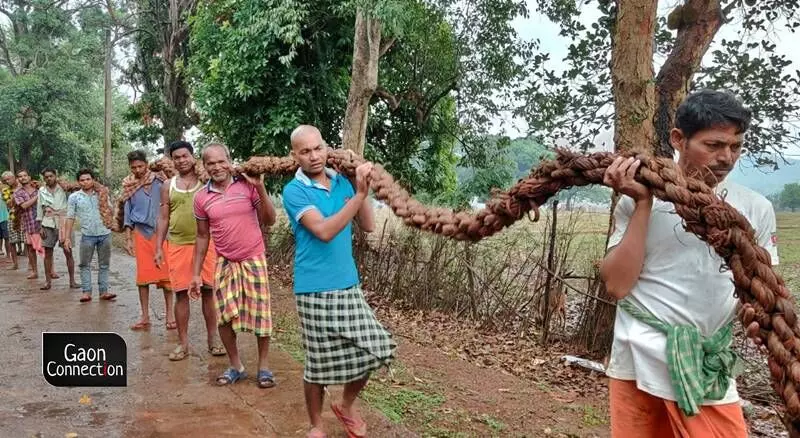Jagannath Yatra: World's largest chariot to be dragged by ropes made by a tribal community in Odisha
In the upcoming Jagannath Yatra festivities slated for the first week of July, preparations are underway for the grand event in Odisha's Kendujhar district. The tribal communities who live on the margins of the society in the coastal state are also contributing to the Rath Yatra by supplying the ropes needed for dragging the chariots to the temple. Details here.
 Ashis Senapati 27 Jun 2022 7:26 AM GMT
Ashis Senapati 27 Jun 2022 7:26 AM GMT

Since the establishment of the temple, tribals have been making ropes from Siali Lata for the Rath Yatra. All photos by Sudrashan Swain
Busy twisting the fibre of a locally found creeper plant to make yarn, 55-year-old Kunja Dehuri expressed her happiness at being able to supply the much needed ropes for the grand procession of Jagannath Yatra in Odisha's Kendujhar district.
"For two years, the annual festivities of the Jagannath Temple were not celebrated in a full-fledged manner due to the Corona. There were a lot of restrictions. Tribal communities like ours have been supplying ropes for the rath yatra and it is an important source of additional income for us," Dehri, a resident of Dehan village in the Kendujhar district told Gaon Connection.
Dehri is amongst the 80 tribal inhabitants in the village who are collectively making 12 ropes — each measuring upto 300 metres long. The fibre for these ropes is sourced from the siali trees which are found in the Gandhamardan forests in the district.
Dehri belongs to a tribal community called Paudi Bhuyans who are known for their sober, simplistic and hardworking nature.
"A single rope weighs around two quintals (200 kilogrammes). The temple authorities pay us Rs 10,000 for a single rope. These ropes are made from creepers of siali lata plant. In the weeks prior to the Jagannath Yatra, we leave all other work and focus on making these ropes," the tribal inhabitant added.
Local creepers provide livelihood for the tribal people
Ramachandra Tisku, the sub-collector of the Keonjhar municipality informed Gaon Connection that the Siali ropes are stronger than the usual coir ropes and provide the much needed tensile strength to pull gigantic chariots during the festive processions.
Siali lata or the siali creeper plant is one of the most economically important plants in the forests of the region as tribals use these creepers for making ropes, baskets, bags and similar stuff.
Also Read: Odisha's Summer Ramleela returns after 2 years of COVID exile
Siali lata or the siali creeper plant is one of the most economically important plants in the forests of the region as tribals use these creepers for making ropes, baskets, bags and similar stuff.
Dehri belongs to a tribal community called Paudi Bhuyans who are known for their sober, simplistic and hardworking nature.
"The Paudi Bhuyan are very simple, sober and hard working people mostly found in Bhuyan Pirha of Keunjhar, Banai mountainous areas, hill tracks of Sundergard and Angul districts. They like to live in hill terrains and valley bottoms. They remain busy at home, field and forest from dawn to dusk and never sit idle," mentions the foreword of a note on the tribe prepared by the Bhubaneswar-based Scheduled Caste and Scheduled Tribe Research and Training Institute
'World's largest chariot in an ancient temple'
Sub-collector Tisku informed Gaon Connection that the 72-feet tall chariot of Lord Jagannath in Keonjhar has been adjudged as largest Ratha Yatra chariot by the Guinness Book of World Records this year.
The Jagannath temple of Keonjhar was built in 1672 by the Maharaja of Keonjhar named Laxminarayan Bhanja.
"Since the establishment of the temple, tribals have been making ropes from Siali Lata for the Rath Yatra. During the Raj period , the Maharaja granted land to Pahadi Bhyan tribes in lieu of their service to provide Siali Lata ropes to the Jagannath temple during the annual Rath Yatra. But after the end of rule of the Raja, rope makers are getting money for their work from the temple management committee. Keeping the age-old tradition alive, we have been using Siali Lata ropes to pull the chariot," Sujit Kumar Dash, the chief priest of the temple told Gaon Connection.
Also, the siali lata plant is closely associated with the themes of history, religion and mythology. The chief priest stated that as per the epic Mahabharata, Lord Krishna died while sleeping on a bed made by siali lata .
Dash also pointed out that the tribal people cut the Siali branches carefully to make sure that it is cut in a way that the branches can re-grow.
More Stories




